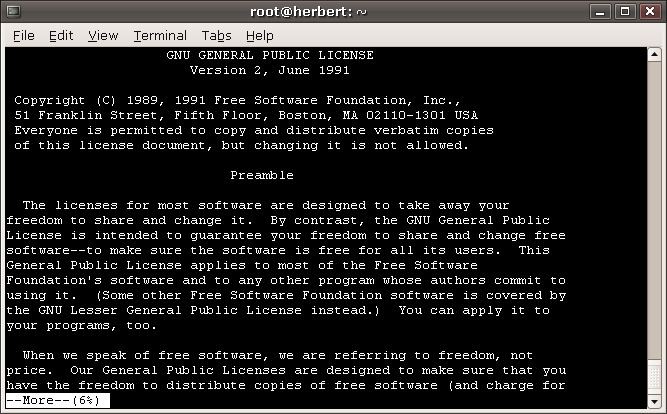Developer(s) Daniel Halbert Operating system | Initial release 1978, 38–39 years ago Type system utility | |
 | ||
In computing, more is a command to view (but not modify) the contents of a text file one screen at a time. It is available on Unix and Unix-like systems, DOS, OS/2, and Microsoft Windows. Programs of this sort are called pagers. more is a very basic pager, originally allowing only forward navigation through a file, though newer implementations do allow for limited backward movement.
Contents
History
The more command was originally written by Daniel Halbert, a graduate student at the University of California, Berkeley, in 1978. It was first included in 3.0 BSD, and has since become a standard program in all Unix systems. less, a similar command with the extended capability of allowing both forward and backward navigation through the file was written by Mark Nudelman during 1983-85 and is now included in most (Unix) and Unix-like systems.
Unix
The command-syntax is:
more [options] [file_name]If no file name is provided, more looks for input from standard input.
Once more has obtained input, it displays as much as can fit on the current screen and waits for user input to advance, with the exception that a form feed (^L) will also cause more to wait at that line, regardless of the amount of text on the screen. In the lower-left corner of the screen is displayed the text "--More--" and a percentage, representing the percent of the file that more has paged through. (This percentage includes the text displayed on the current screen.) When more reaches the end of a file (100%) it exits. The most common methods of navigating through a file are Enter, which advances the output by one line, and Space, which advances the output by one screen.
There are also other commands that can be used while navigating through the document; consult more's man page for more details.
Options
Options are typically entered before the file name, but can also be entered in the environment variable $MORE. Options entered in the actual command line will override those entered in the $MORE environment variable. Available options may vary between Unix systems, but a typical set of options is as follows:
Microsoft Windows
The command-syntax is:
command | more [/c] [/p] [/s] [/tn] [+n]more [[/c] [/p] [/s] [/tn] [+n]] < [Drive:] [Path] FileNamemore [/c] [/p] [/s] [/tn] [+n] [files]Examples
To display the file named letter.txt on the screen, the user can type either of the following two commands:
more letter.txttype letter.txt | moreThe command displays the first screen of information from letter.txt, and then the following prompt appears:
-- More --When the spacebar is pressed, the next screen of information will be displayed. It is also possible to clear the screen and remove all extra blank lines before displaying the file:
more /c /s < letter.txttype letter.txt | more /c /sOS/2
The command-syntax is:
MORE < [drive:][path]filenamecommand | moredrive:path
ilename – Specifies the location of the file to display one screen at a time.command | – Specifies the command whose output will be displayed.Example
Return the content of the OS/2 system directory using the dir command and display it one screen at a time using the more command:
